Unless otherwise stated the pictures and text for this article come from 26th Annual Tri-State Pottery Festival Plate Turners Handbook. June 17, 18, 19, 1993.
THROUGH MANY CHANGES, DOORKNOB TOSSING - REMAINS A GAME OF SKILL AND FUN
By Fred Miller
Doorknob tossing is a traditional folk game which originated in East Liverpool. Based loosely on the game of horseshoes, it utilized imperfect ceramic doorknobs which were discarded literally by the millions over the 98-year period (18491947) of their manufacture in this city.
With the founding this year of the American Doorknob Tosser Association it is an appropriate time to reflect On some of the changes seen in this game native and unique to East Liverpool, Ohio.
A backyard or street game, it was usually played on a bare dirt court. A tin can would be buried straight or at an angle and players attempted to slide tossed knobs into the can. Sometimes a ring was drawn in the dirt to make a court.
As with any folk game, scoring and rules varied considerably. One variation was to draw a straight line in the dirt and attempt to straddle it with your knob. If an opponent made a good throw, a strategy was to try to knock it off with yours, as in shuffleboard.
The Tri-State Pottery Festival was inaugurated in 1968 and the game of tossing knobs was added to the activities in 1969. It was staged at the Salvation Army. In this period it was apparently all singles competition. For example, Steve Hall was 1974 winner and William Heredith was runner-up. In 1975, Gus Mautz was champ and Stan Ward was runner-up.
This period of competition ended in 1978, when festival organizers tired of wading out into the Ohio River to try to find enough old knobs to play with.
Harold "Sonny" Rayle, a Homer Laughlin employee and a champion tosser in the early '70s, solved this problem of lack of knobs by hand-modeling a few knobs at HLC just for tossing. The game was revived as a festival event in 1985. To make the courts, HLC workers cut sections out of 55-gallon steel drums, arranged them on the Lawn at the Salvation Army at 4th and Walnut streets, filled them with sand and put a one- pound coffee can in the middle as a target.
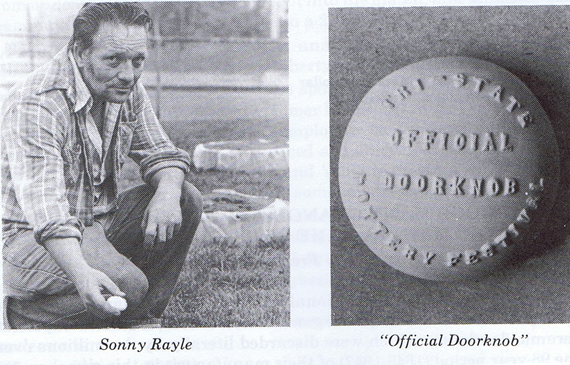
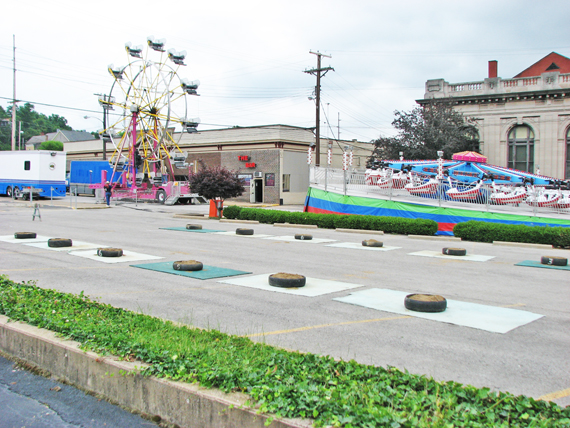
The official layout for the Pottery Festival. Picture taken by EL Historical Society personal from the 2010 Pottery Festival.
John Thompson of Hall China Co. was among those pottery executives tossing against Pottery Union officials including Wayne King during special grudge matches in 1985.
Doorknob tossing captured everyone's imagination, mine included, and I hit upon the idea of manufacturing and marketing a doorknob toss game. With a lot of faith, the cooperation of Homer Laughlin, and much hard work by festival volunteers, games were assembled and sold in basic and deluxe sets.
The 1986 festival was proclaimed "The Year of the Knob," and that it was.
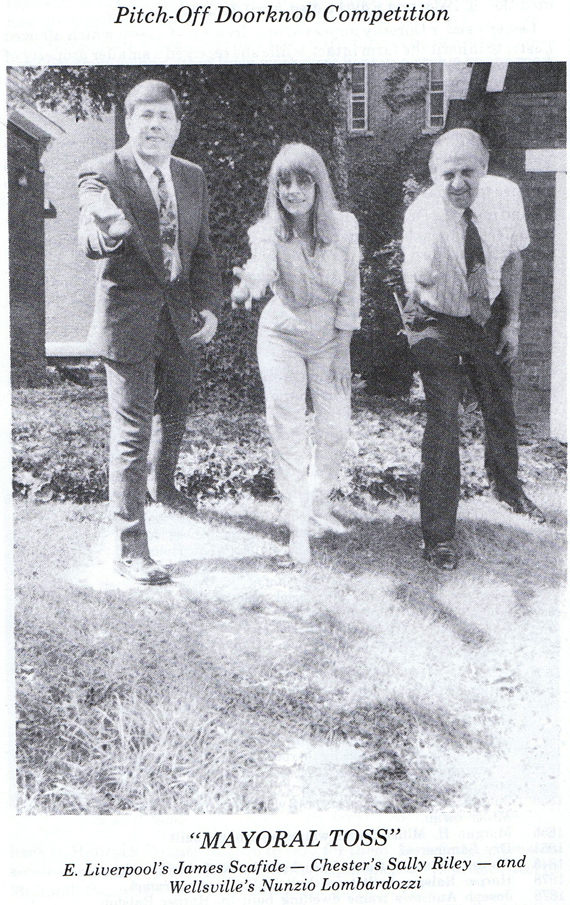
From the 25th Annual Tri-State Pottery Festival Plate Turners Handbook, June 18, 19, 20, 1992.
The knob competition, which was proclaimed the national championships and featured the addition of doubles competition, was held on the gravel lot on Fourth Street which was the Old Central School site. It later became the site of the ELHS Alumni Building. I'm not sure whose bright idea it was to use old tires instead of steel barrel sections, but the change was adopted instantly and gratefully. We also abandoned tin cans as the center targets in favor of sections of four-inch plastic sewer pipe cut to lengths of about five inches.
Over the previous winter I had chaired a rules committee which formalized the game's rules, and had persuaded City Council to pass legislation naming doorknob tossing East Liverpool's official game. At the 1986 competition, we drew reporters from the Cleveland Plain series of both informal competitions and sanctioned tournaments every year. Eventually we hope to spread the game of knob-tossing across the land as the best backyard game in America.
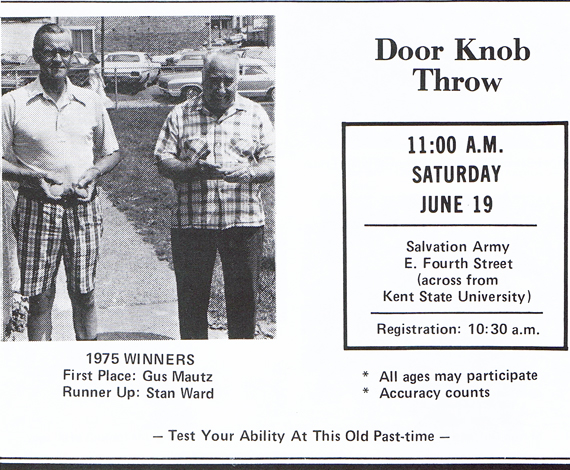
Ninth Annual Tri-State Pottery Festival. 1976.
The ADTA will run its first sanctioned tournament June 5 at 3 p.m at the Broadway Wharf as an event of the 1993 Riverfest. The second sanctioned tournament will be the national Championships during the Pottery Festival. The third is scheduled at the lower pavilion in Thompson Park on Saturday, July 10 at 3 p.m. The fourth will be on a date to be chosen in early fall.
Future activities of the ADTA will include member picnics and winter indoor tournaments. (We held two indoor competitions in 1993 at a pole building lent to us by Tom Ogden near Newell).
A rules committee will discuss changes and variations as the game evolves. It is the policy of the ADTA, however, that any "official" rule changes must be approved by the Pottery Festival Association, which owns the copyright on the doorknob game rules. The ADTA plans to use only official Pottery Festival knobs, and will not attempt to compete with the festival in the manufacture and sale of knobs. Its only role in sales will be as an agent of the festival association.
This policy, however, won't prevent the ADTA from experimentation with rule changes and special variations. For example, Bill Triplett's suggestion to increase the center target to six inches in diameter is considered heresy by some, a good idea by others, but most certainly will be tried. An old-time tournament featuring variations on folk rules is another possibility.
No matter whether rules are official or not, doorknob tossing remains a
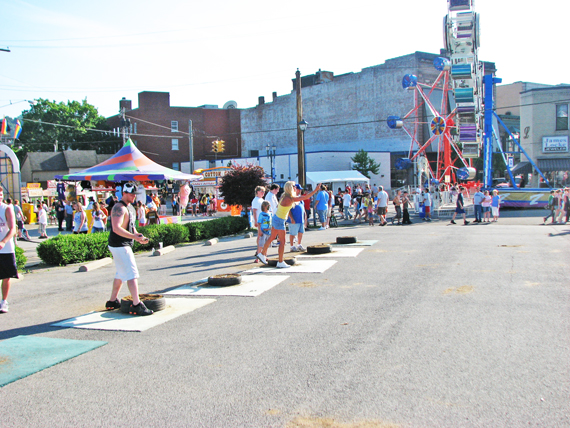
Men and women, boys and girls. All can enjoy this game. Pottery Festival, 2011.
game with almost infinite variations, and players should always remember that the idea is to set up a court and rules which are both fun and fair. For example, making a court where the targets are plastic buckets half filled with water, or setting water buckets around the yard to make a "golf course," are two great hot-weather variations with a special appeal to kids.
ROBINSON, VINCI AND TRIPLETT
DOMINATE MODERN AREA OF DOORKNOB TOSSING
By Fred Miller
It's what Palmer and Nicklaus did on a golf course and Michael Jordan does on the hardwood, It's Wayne Gretzky and Mario Lemieux on ice. We're talking individual domination of a sport.
In doorknob tossing, there are three dominant names: Robinson, Vinci and Triplett.
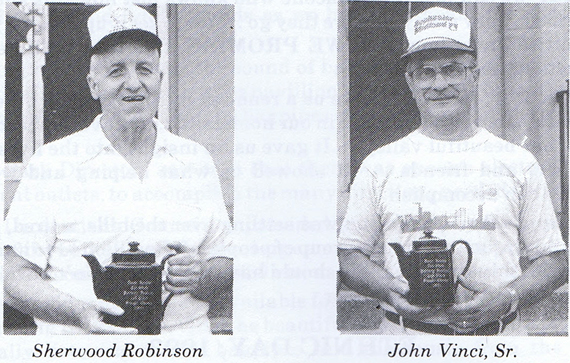
By any standard, the three reigning champions of this period are Sherwood Robinson of East Liverpool, John Vinci Sr. of Chester and Bill Triplett of Newell.
Since doorknob tossing was reintroduced as a Pottery Festival event in 1985 (and declared the national championships in 1986) each of these men have won a remarkable four championships, two each in singles and doubles.
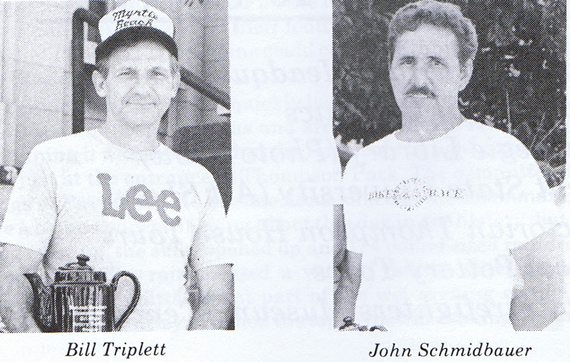
To say it another way, they (and their doubles partners) own 15 of the total 21 first-place teapot trophies awarded over that eight-year span, an amazing achievement.
Robinson has a slight edge in overall trophies with eight, while Vinci has seven and Triplett owns six. The next closest competitor in terms of trophies is John Schmidbauer, a talented tosser who won five trophies -two of them first-place- from 1985 through 1988 but has only competed once since.
This is not to say that the others who won trophies during this period
weren't deserving (a snide comment from one who has yet to win a trophy) but often they got to the winner's circle only after Robinson, Vinci and Tripplett knocked each other off in earlier rounds. Players have not usually been seeded, so the luck of the draw has often paired top tossers against each other in early rounds.
At the same time, one should have a little sympathy for the tossers of slightly lesser talent who keep bumping up against this super trio.
Consider Gary Ward, who in 1992 earned what was possibly the hardest-won third-place trophy ever given in a singles knob-toss competition.
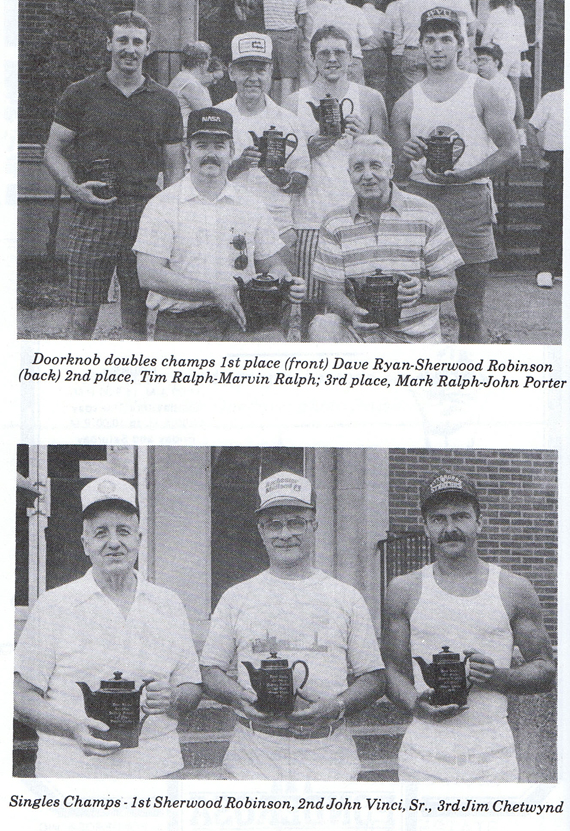
Ward defeated John Vinci Sr. 21-16 and Sherwood Robinson 21-19 before falling to second-place winner Dave Randolph Sr. 21-19 and champion Bill Triplett 22-19. In Ward's last match, he and Triplett were tied 19-19 when Ward threw a ringer, only to have Triplett top it, cancelling it out. On the next toss, Triplett hit another ringer to seal his victory.
You have to feel for David Randolph Sr., a good tosser who is always the bridesmaid but never the bride. In singles competition, he finished second to Robinson in 1986, second to Vinci in 1990 and second to Triplett in 1992.
Another in the hard-luck category is David Ryan, who has partnered with his father-in-law Sherwood Robinson to win two doubles championships, plus a second and a third in doubles, but himself has yet to win in national singles competition. (He did win the singles competition at the 1992 East Liverpool Riverfest, however, and has never forgiven this writer for not getting the results in the newspaper).
The value of a good doubles partner cannot be overstated, for it takes two to win a match. Vinci teamed with his son John Jr., then a resident of Norfolk, Va., for a doubles third place in 1988 and came back the next year to take first.
But the all-time champion doubles team is Robinson and Ryan with four doubles trophies - two firsts, a second and a third.
In the 1987 doubles finals, for example, Robinson and Ryan were locked in a dramatic duel with Ray Radcliffe and young John McFarlane. The match was tied 19-19 when Ryan dropped a double ringer to end it with a bang, 25-19.
In contrast, a double ringer by Bill Triplett at the outset of the 1986 final doubles match took all the drama out of that contest. John Schmidbauer and Richard "ACE" Cameron must have felt the floor drop from under them! They never really got into the match, and Triplett with teammate Lester Landfried coasted to a 21-10 win.
Two years later in 1988, Triplett and LÓndfried lost a thriller to Schmidbauer and Thomas "Doc "Doherty in the double finals, 22-20.
Landfried, a soft-spoken man who sported a distinctive handlebar mustache, was a forklift driver at Homer Laughlin China Co. in Newell, He, Vinci, Triplett and other HLC employees set up courts outside the pottery in the late 1980's and practiced at Lunchtime. After Landfried died on January 26, 1991, Triplett and Vinci teamed up in doubles, a move other players grumbled should somehow be against the law.
Their partnership paid off with a doubles championship in 1992, which Triplett sweetened with a win in the singles tournament the next day.
The only tosser to duplicate that feat (winning in both doubles and singles in the same year) was - you guessed it - Sherwood Robinson, in 1991.
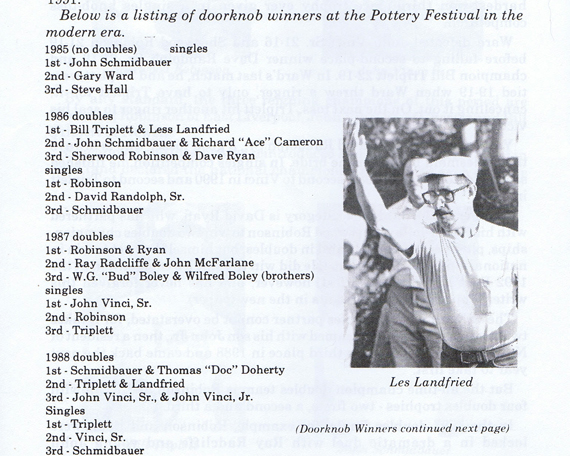
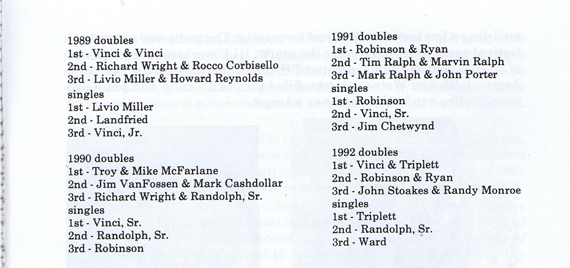
BECOME A CHARTER MEMBER OF THE AMERICAN
DOORKNOB TOSSERS ASSOCIATION
If a person is a serious knob tosser or just loves the folklore and traditions of East Liverpool's pottery heritage, that person should consider becoming a charter member of the American Doorknob Tosser Association.
For a one-time payment of $25.00 for a basic charter membership, the member will receive a wallet card, a handsome certificate suitable for framing, and a dazzling gold-plated doorknob with raised letters stating "ADTA Charter Member." Some charter members will put their guilded knobs in their safety deposit boxes as collector's items, but I suspect most of us will leave them on our desk at work or end table at home for friends to pick up and ask about.
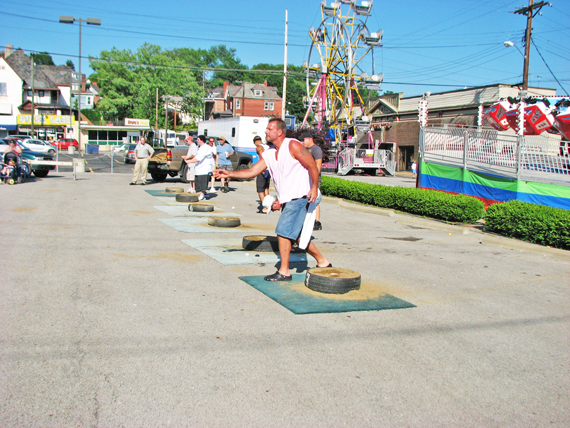
For only $10.00 more, a charter member can also receive an official ADTA T-shirt, ballcap and set of six official tossing doorknobs in a limited-edition, specially colored set authorized by the Tri-State Pottery Festival exclusively for ADTA charter members.
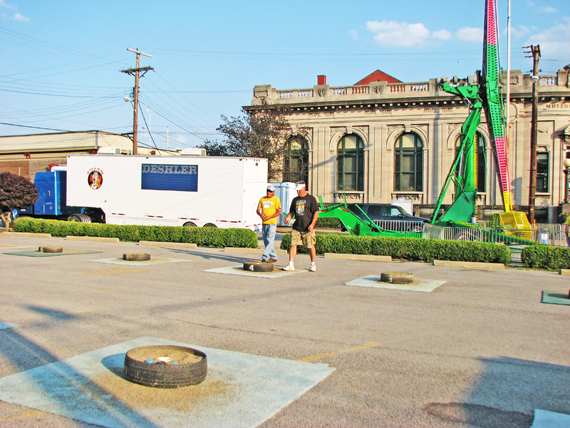
Charter memberships can be purchased until December 31, 1993, by sending either $25.00 for basic package or $35.00 for the deluxe package to: [no longer valid] If the set is to be mailed, add $3.50 for the basic set and $5.00 for the deluxe set for postage and handling. If notification of upcoming tournaments and events by receiving the ADTA newsletter and continuing voting membership privileges are desired, $10.00. in annual dues should be added. For the deluxe set, be sure to specify T-shirt size. Make checks payable to ADTA. Specify exact wording of name as it is to appear on the certificate, wallet card and in the newsletter.
Obviously this has expired. We need a person or a group or a institution to take over this task again and keep it going.
Charter memberships purchased as gifts will be sent as such, with a card noting by whom and for whom the membership was purchased and including a personal message.
Charter memberships may be purchased by or for individuals, couples, families, businesses and organizations. The buyer should specify exactly how the charter member's name is to appear.
This site is the property of the East Liverpool Historical Society.
Regular linking, i.e. providing the URL of the East Liverpool Historical Society web site for viewers to click on and be taken to the East Liverpool Historical Society entry portal or to any specific article on the website is legally permitted.
Hyperlinking, or as it is also called framing, without permission is not permitted.
Legally speaking framing is still in a murky area of the law
though there have been court cases in which framing has been seen as violation of copyright law. Many cases that were taken to court ended up settling out-of-court with the one doing the framing agreeing to cease framing and to just use a regular link to the other site.
The East Liverpool Historical Society pays fees to keep their site online. A person framing the Society site is effectively presenting the entire East Liverpool Historical Society web site as his own site and doing it at no cost to himself, i.e. stealing the site.
The East Liverpool Historical Society reserves the right to charge such an individual a fee for the use of the Society’s material.